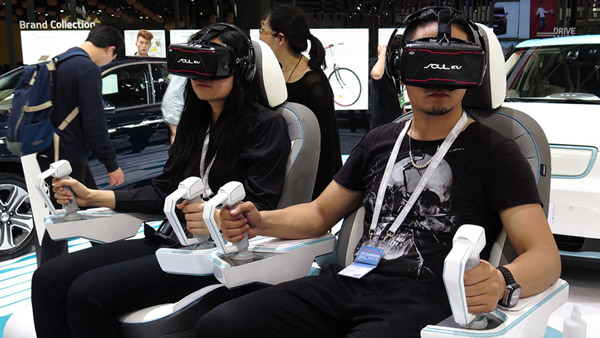VR is Expected to Restructure Industries in China
The global popularity of VR rapidly grew in 2014. Now in 2017, after two years of investments and exploration, virtual reality is growing into more and more industries, changing the traditional value chain, and revolutionizing the customer’s’ experience. In the automotive sector, VR has multiple impacts on the industry in terms of design, consumer feedback, and customer purchasing. Many automakers have started to combine their manufacturing process and model presentation with VR technology. China has become one of the first countries to jumpstart VR research and development. Globally, VR is expected to be a growing trend of the future.
Chinese Government Prioritizes VR and Funds a Basement in Xi’an
Similar to the global trend of VR, the Chinese VR market developed quickly. In December 2016, the Chinese government introduced “The 13th Five-year national information plan” which prioritizes the development of VR. In 2016, the government also built Xi’an as the main research basement for VR by founding an AR/VR innovation alliance. Xi’an has attracted 42 initial members including Xi’an Transportation University and various high-tech companies.
In 2016, the Chinese market size of VR grew 343% to 6.82 billion over the same period last year. Currently, the high price of VR equipment and low compatibility of platforms cannot match the market demand. The market size will likely expand to 56 billion in 2020 when most of the technical problems are expected to be solved.
Top Automotive Brands are using VR to Reduce Cost in Design and Manufacturing
Although customers may pay more attention to the fancy driving experience with VR, the design and manufacturing process will benefit the most from VR technology. At the basis of CAD technology, VR helps designers check whether their vehicle model is reasonable in beauty and mechanism through a close 3D observation.
Designers can even change the parts and surroundings through data adjustments to further improve vehicle performance in different environments. This largely reduces design and research costs. For example, Ford has successfully applied this method at their Immersion Lab. Here, the staff is able to simulate sunny days, cloud cover, and night time in real time allowing for design improvement discussion to take place more efficiently. Audi also applied VR to their assembly line where they imitated a 3D virtual space with machine parts to help workers estimate the whole assembly process. Their workers can constantly practice the assembly process which reduces rejection rate without any extra training costs.
Customers will Obtain a More Convenient and Enjoyable Car Buying Process through VR
There is a huge potential of using VR to create a better sense of participation in customers to improve conversion rates. Before VR application, even if customers have already entered retailer’s stores, it’s hard for salesmen to give all the vehicle information that designers have added. VR aims to enrich the customer’s’ experience by allowing customers to select and combine different parts (e.g. outside colors, engine type). VR glasses also allow for people to feel as if they are driving on the road. Toyota and Oculus have already developed a virtual driving simulator called “TeenDrive 365” to help teenagers safely practice their driving skills. These VR functions can extend customers average staying time in a dealer’s store to enhance the purchasing motive for customers.
VR also allows for customers to test out new vehicles from the comfort of their homes. As the popularity of VR hardware increases, it is likely to replace the traditional way that buyers test drive new cars. Companies that develop these methods can easily acquire new customers as well as attract customers from competitors through VR’s accessible vehicle presentation.
How Can VR Work for Market and Customer Analysis?
VR performs as an engine for the development of custom-made cars supported by high net worth individuals. It is much clearer for designers to understand their customers’ needs because customers can easily experience 3D vehicle samples and further develop their opinions.
At the same time, VR plays an important role in the market test. British automaker, Jaguar Land Rover, is planning to let customers wear their VR headset as a new way of introducing their vehicle model before it’s even released. This helps automakers forecast market demands and consumer reactions. Through the application of VR, firms can make a precise estimation about how the market thinks of their new model and then adjust their vehicle model accordingly.
From our research, using VR to analyze customers will be more and more important for automakers. Through a 360-degree view of “headset interviews” with VR, interviewees could deeply explore new vehicles and give their insight. As a result, the true market demand will be more visible to seize, which effectively decreases the design costs. VR surveys will add more fun into the process which is helpful for manufacturers to market their brands. As a market consultation firm, we are also researching the market analysis approach with VR, and we hope to cooperate with automotive manufacturers in the near future.
Conclusion:
As mentioned above, VR is an ideal match for the automotive industry. With better compatibility and popularization of VR headsets, automakers can produce more awesome cars at lower costs. Customer demand can also be fitted more appropriately with a fantastic car purchasing process.
There are only around 100 million VR systems globally as of 2016 (including PC & mobile equipment and Cardboard), and recently customers cannot experience online driving test everywhere. But here, we will provide three temporary solutions for customer based automotive services.
- Cooperate with VR game producers, especially motor game firms. For game players who are interested in automotive and have already bought VR equipment, they are definitely willing to learn about the actual driving feeling of real vehicles.
- Connect with some offline VR centers located in main shopping malls. Driving tests with VR could also be taken as a new VR experience, which present manufacturers with new models.
- Try to apply VR to the custom made cars market and target high net worth customer, because it’s easier to adjust the products according to customer’s’ experience provided by VR.
To learn more specific insight about automotive and VR, do not hesitate to contact our dedicated project manager by email at dx@daxueconsulting.com.
Featured image: www.chinadaily.com/cn





